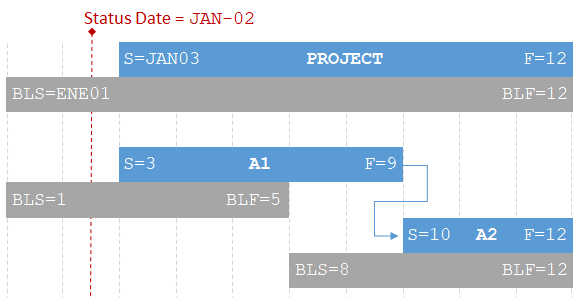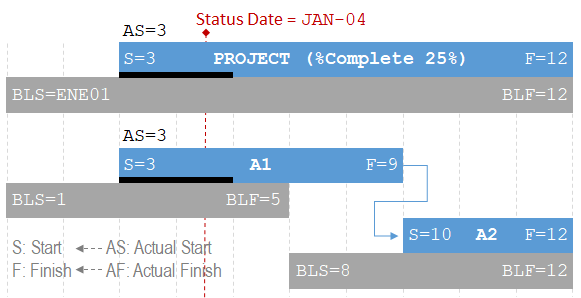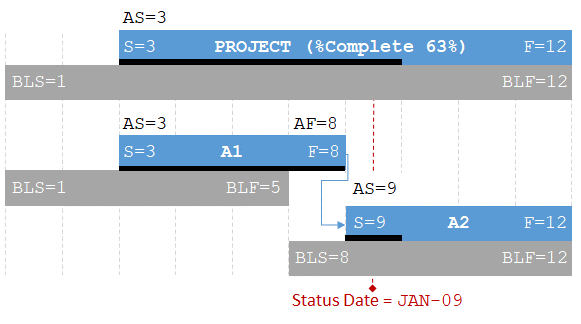Professional project managers need to measure project performance regularly, so that they can take corrective actions to adjust the project to reduce deviations. Our dear Rita Mulcahy advised us to do so in this 7 minutes video:
That is, in project review meetings, we need to measure and adjust: we report project performance in front of a steering committee and propose corrective actions to get the project back on track. We have to measure and adjust regularly, comparing actual performance to the plan. We have to take corrective actions when we have time, our options are still open, and agreements can be reached. This is the key to meet the project goals, to get the project on time, on budget, etc.
Let’s say that today we have an over cost of 10,000€. How could we save 10,000€ to finish on budget? Our time variance at completion is 3 weeks. How could we save 3 weeks to finish on time?
Good project managers have the habit of reporting performance regularly. They know that status reports are essential. If they don’t have follow up meetings, chances are their projects finish late and over budget, and they will be blamed.
Think of a non-professional project management, who manages the project just by tracking tasks. How is he different from a professional one? The main distinction is that the project management professional reports periodically to a project steering committee. While reporting about the project, this professional is also involving key stakeholders in the problems and seeking the solutions with them.
Let’s say a professional project manager anticipates a problem that could make the project late or over budget. He does not need to solve this on his own, or just with the help of his project management team. He should discuss this risk in the follow up review, using a document called “status report”, proposing several responses to help steering committee get a decision. If this risk eventually happens, this will not be his fault.
Let’s see this in practice. Let’s focus on how to meet the schedule management goal. How can we make projects finish on time? If we make it, this is not by accident. Regular project status reports are needed to monitor the actual dates against the planned ones, to measure current and forecast variances, and to take corrective actions to get back on track.
Professional schedule project management consists basically of involving people in the problems and working out solutions together. Some stakeholder examples are: steering committee members, PMO, governance structures, etc. When you forecast a final delay of 10 days, how can you save 10 days throughout the rest of the project? You can use schedule compression techniques like crashing or fast-tracking, or you can simply recommend scope exclusions or moving some deliverables to the next phase, for instance.
Professional project managers are familiar with schedule management terminology. Stakeholders won’t think of them as good professionals if they don’t control schedule correctly.
The good news is schedule control techniques are highly standardized. In order to control the project schedule, you need to control it at the lowest level: Activities are the lowest lines of a Ganttt chart.
Precisely, you need to control 3 couples of dates for each activity:
- Baseline Start and Baseline Finish tell us the committed dates for start and finish.
- Actual Start and Actual Finish keep record for the actual start and finish dates.
- Start and Finish are used to keep our best estimation on activity starts and finishes. They need to be updated whenever we have a better knowledge. When actual dates are updated, then you need to copy those values here. For instance, if an activity has started already, then it has to have a value for Actual Start. That same value needs to be copied to Start. It makes no sense if estimates are different from actuals.
To see all this in detail, let’s try to imagine 5 status reports for a very simple project:
Kick-off Meeting
Let’s imagine we have this project. For simplification purposes, let’s assume planned duration is 10 days, starting Monday 2018–01–01 and finishing Friday 2018–01–12:

It is difficult to manage any project as a whole, so we need to decompose into activities. To simplify again, let’s have only two activities A1 and A2, 5 days each, depending Finish-to-Start. A1 finishes on Friday 5. A1 starts on Monday 8.

Now we have the dates each activity is supposed to start and finish. Logically, if we control these activities finish those dates, then the project should finish on time.
Let’s say we have our kick-off meeting and our main stakeholders agree with our proposed schedule: This is the time to set the project schedule baseline.
This will be our reference to compare actual data. Setting the baseline is like taking a snap shot of the project dates. In the figure above you can see each Baseline Start is set to the value of Start and each Baseline Finish is set to the value of Finish.
First Follow-up Review
Let’s imagine we have our first follow-up review on day 2: status date is day 2.

As you can see in the figure, first activity has not started yet. We need to re-schedule it to start on day 3. We keep duration estimate of 5 days, so it has to finish day 9: our best A1’s estimates for Start and Finish are days 3 and 9, respectively.
Comparing to baseline, you can appreciate visually the current variance of 2 days for A1. We use the formula: Finish Variance = Finish – Baseline Finish.
Activity A2 is also delayed because it needs to start after A1 is finished, that is, on day 10, but we estimate no final delay because we update duration estimation to 3 days, instead of 5. Our best estimate for A2’s Finish is still 12. The project will not be delayed (Finish = 12 and Baseline Finish = 12)
Second Follow-up Review
We have our second follow-up review on day 4. Let’s assume activity 1 has started on day 3. We can say Actual Start = 3. The rest of the scheduling remains the same.

If we update bottom up, we can calculate the project dates Start = Actual Start = day 3, Finish = day 12.
On the other hand, when you have actual progress, this is the case for A1, which has started already, you can communicate %Complete –a.k.a. percent spent – for activities, and also for the project. This is calculated dividing actual duration over duration. When an activity is finished, it has to have a value for Actual Finish, which should be the same than Finish, and %Complete=100%.
In our case, if A1 has progressed 2 days over 5, then %Complete = 40%. Regarding to the project summary, %Complete = 25% =2/8.
Third Follow-up Review
Let’s move to the third follow-up review on day 9. We report A1 finished effectively on day 8, one day earlier than planned on the last review. A2 has progressed 1 day and we keep our estimates to be finished on day 12. That is, we adjust our duration estimate from 3 to 4 days.

The project summary does not change dates. We can update project %Complete to 63%: A1 is done and A2 has progressed 1 day over 4, so %Complete = (4*100%+4*25%)/(4+4) = 5/8 = 63%.
Closing Review
Let’s go finally to the closure report: The project finished on day 11, one day earlier than planned, because activity A2 saved one more day.

See a short summary in this video (8.5 min):
PMPeople is aimed to unify professional project management by these differential points:
- Designed by and for professional project managers, following professional project management standards.
- Online productivity –less meetings, less documents, less workflows– through distributed collaboration among 12 specialized roles: Organization Owner, 6 roles on demand management and 5 roles on supply management.
- Freemium product –unlimited time, unlimited users, only managers have to pay– usable via web and mobile application.
Start using PMPeople for free, for unlimited time and for any number of users. In premium organizations, only managers have to pay 20€ a month. Several roles –stakeholders, team members, sponsors and resource managers– are always free. You can increase or decrease your premium seats according to the organization actual needs. Premium organizations have access to our interactive support through Slack. Our servers are located in EU. This software can also be hosted on customer premises.
Jose Barato
Related posts
Categories
- Business (16)
- Demand Management Roles (14)
- Frequently Asked Questions (7)
- Guide (26)
- People (23)
- Assignments (2)
- Feedback (2)
- Project Team (3)
- Tracking Time And Expenses (2)
- Process (9)
- Closing (2)
- Executing And Controlling (2)
- Planning (1)
- Project Management (67)
- Management Frameworks (18)
- Organization Owner (OO) (3)
- Project Economy (54)
- Tools (19)
- Supply Management Roles (5)
- Training (6)
- Uncategorized (1)




